Revealing Virtual Water Transfers and Imbalanced Economic Benefits Hidden in China’s Interprovincial Trade
Abstract
:1. Introduction
2. Methodology
2.1. Multiregion Input–Output Analysis
2.2. Interprovincial Virtual Water and Value-Added Transfer Imbalances Index
2.3. Structural Path Analysis
2.4. Data Sources
3. Results and Discussion
3.1. Accounting of Virtual Water and Value Added on the Production and Consumption Side
3.2. Net Transfers of Virtual Water and Value Added
3.3. Imbalances of Virtual Water and Economic Benefits in Bilateral Trade
3.4. Virtual Water Transfers and Imbalanced Economic Benefits in Different Tiers
3.5. Key Virtual Water Supply Chain Paths and Imbalanced Economic Benefits in Two Case Provinces
4. Conclusions and Policy Implications
Author Contributions
Funding
Institutional Review Board Statement
Informed Consent Statement
Data Availability Statement
Conflicts of Interest
Appendix A
| No. | Name of Provinces or Cities | Region |
|---|---|---|
| 1 | Beijing | Beijing–Tianjin |
| 2 | Tianjin | |
| 3 | Hebei | north |
| 4 | Shandong | |
| 5 | Liaoning | northeast |
| 6 | Jilin | |
| 7 | Heilongjiang | |
| 8 | Shanghai | east coast |
| 9 | Jiangsu | |
| 10 | Zhejiang | |
| 11 | Fujian | south coast |
| 12 | Guangdong | |
| 13 | Hainan | |
| 14 | Anhui | central |
| 15 | Shanxi | |
| 16 | Jiangxi | |
| 17 | Henan | |
| 18 | Hubei | |
| 19 | Hunan | |
| 20 | Guangxi | southwest |
| 21 | Chongqing | |
| 22 | Sichuan | |
| 23 | Guizhou | |
| 24 | Yunnan | |
| 25 | Inner Mongolia | northwest |
| 26 | Shaanxi | |
| 27 | Gansu | |
| 28 | Qinghai | |
| 29 | Ningxia | |
| 30 | Xinjiang |
Appendix B
| No. | Name of Sectors | Name Abb. |
|---|---|---|
| 1 | Agriculture, forestry, and fishing | Agriculture |
| 2 | Coal mining | CoalMining |
| 3 | Mining of petroleum and natural gas | CrudeOilGas |
| 4 | Metal ores mining | MetalOre |
| 5 | Non-metallic minerals mining | NonmetalOre |
| 6 | Production of food and tobacco | FoodTobacco |
| 7 | Textiles | Textiles |
| 8 | Wearing apparel, leather, fur, etc. | ClothingLeather |
| 9 | Wood processing and furniture | WoodFurniture |
| 10 | Papermaking, printing, stationery, etc. | PaperPrinting |
| 11 | Fossil fuel refining | PetrolCoking |
| 12 | Chemical industry | Chemical |
| 13 | Production of non-metallic mineral products | NonmetalProducts |
| 14 | Smelting and processing of metals | MetalSmelt |
| 15 | Metal products | MetalProducts |
| 16 | General and special equipment | GeneralSpecialEquip |
| 17 | Transport equipment | TransportEquip |
| 18 | Electrical equipment | ElectricalEquip |
| 19 | Electronic equipment | ElectronicEquip |
| 20 | Measuring instruments and meters | MeasureInstru |
| 21 | Other processing products | OtherProc |
| 22 | Electricity and heat power | ElectricHeatpower |
| 23 | Gas supply | GasSupply |
| 24 | Water supply | WaterSupply |
| 25 | Construction | Construction |
| 26 | Transport and warehousing | TranspWarehouse |
| 27 | Wholesale, retail, hotels, and catering | WholeRetailHotel |
| 28 | Other services | OtherServices |
References
- World Bank Database. 2022. Available online: https://data.worldbank.org/indicator/ER.H2O.INTR.PC?name_desc=false&view=chart (accessed on 3 January 2022).
- China Statistical Yearbook 2021; China Statistics Press: Beijing, China, 2021. (In Chinese)
- Liu, J.; Zang, C.; Tian, S.; Liu, J.; Yang, H.; Jia, S.; You, L.; Liu, B.; Zhang, M. Water conservancy projects in China: Achievements, challenges and way forward. Global Environ. Chang. 2013, 23, 633–643. [Google Scholar] [CrossRef] [Green Version]
- Berkoff, J. China: The south–north water transfer project—Is it justified? Water Policy 2003, 5, 1–28. [Google Scholar] [CrossRef]
- Krugman, P.R. Intraindustry specialization and the gains from trade. J. Polit. Econ. 1981, 89, 959–973. [Google Scholar] [CrossRef]
- Song, M.; Wang, S. Market competition, green technology progress and comparative advantages in China. Manage. Decis. 2018, 56, 188–203. [Google Scholar] [CrossRef]
- Liu, J.; Mooney, H.; Hull, V.; Davis, S.J.; Gaskell, J.; Hertel, T.; Lubchenco, J.; Seto, K.C.; Gleick, P.; Kremen, C.; et al. Systems integration for global sustainability. Science 2015, 347, 1258832. [Google Scholar] [CrossRef] [Green Version]
- Zhang, Q.; Jiang, X.; Tong, D.; Davis, S.J.; Zhao, H.; Geng, G.; Feng, T.; Zheng, B.; Lu, Z.; Streets, D.G.; et al. Transboundary health impacts of transported global air pollution and international trade. Nature 2017, 543, 705–709. [Google Scholar] [CrossRef] [Green Version]
- Dou, Y.; Zhao, J.; Malik, M.N.; Dong, K. Assessing the impact of trade openness on CO2 emissions: Evidence from China-Japan-ROK FTA countries. J. Environ. Manag. 2021, 296, 113241. [Google Scholar] [CrossRef]
- Hoekstra, A.Y.; Mekonnen, M.M. The water footprint of humanity. Proc. Natl. Acad. Sci. USA 2012, 109, 3232–3237. [Google Scholar] [CrossRef] [Green Version]
- Cai, B.; Wang, C.; Zhang, B. Worse than imagined: Unidentified virtual water flows in China. J. Environ. Manag. 2017, 196, 681–691. [Google Scholar] [CrossRef] [Green Version]
- Tian, X.; Sarkis, J.; Geng, Y.; Qian, Y.; Gao, C.; Bleischwitz, R.; Xu, Y. Evolution of China’s water footprint and virtual water trade: A global trade assessment. Environ. Int. 2018, 121, 178–188. [Google Scholar] [CrossRef]
- Allan, J.A. ‘Virtual Water’: A Long-Term Solution for Water Short Middle Eastern Economies? School of Oriental and Asian Studies, University of London: London, UK, 1997; pp. 24–29. [Google Scholar]
- Marston, L.; Konar, M.; Cai, X.; Troy, T.J. Virtual groundwater transfers from overexploited aquifers in the United States. Proc. Natl. Acad. Sci. USA 2015, 112, 8561–8566. [Google Scholar] [CrossRef] [PubMed] [Green Version]
- Liu, X.; Du, H.; Zhang, Z.; Crittenden, J.C.; Lahr, M.L.; Moreno-Cruz, J.; Guan, D.; Mi, Z.; Zuo, J. Can virtual water trade save water resources? Water Res. 2019, 163, 114848. [Google Scholar] [CrossRef] [PubMed]
- Zhang, W.; Fan, X.; Liu, Y.; Wang, S.; Chen, B. Spillover risk analysis of virtual water trade based on multi-regional input-output model-A case study. J. Environ. Manag. 2020, 275, 111242. [Google Scholar] [CrossRef] [PubMed]
- Helpman, E.; Krugman, P. Market Structure and Foreign Trade: Increasing Returns, Imperfect Competition, and the International Economy; MIT Press: Cambridge, MA, USA, 1987. [Google Scholar]
- Xiong, Y.; Zhang, Q.; Tian, X.; Li, H. Environmental inequity hidden in skewed water pollutant–value flows via interregional trade in China. J. Clean. Prod. 2021, 290, 125698. [Google Scholar] [CrossRef]
- Xin, M.; Wang, J.; Xing, Z. Decline of virtual water inequality in China’s inter-provincial trade: An environmental economic trade-off analysis. Sci. Total Environ. 2022, 806, 150524. [Google Scholar] [CrossRef] [PubMed]
- Wang, S.; Cao, T.; Chen, B. Identifying critical sectors and supply chain paths for virtual water and energy-related water trade in China. Appl. Energy 2021, 299, 117294. [Google Scholar] [CrossRef]
- Leontief, W. Input-Output Economics, 2nd ed.; Oxford University Press: Oxford, UK, 1986. [Google Scholar]
- Zhang, C.; Anadon, L.D. A multi-regional input–output analysis of domestic virtual water trade and provincial water footprint in China. Ecol. Econ. 2014, 100, 159–172. [Google Scholar] [CrossRef]
- Jiang, Y.; Cai, W.; Du, P.; Pan, W.; Wang, C. Virtual water in interprovincial trade with implications for China’s water policy. J. Clean. Prod. 2015, 87, 655–665. [Google Scholar] [CrossRef]
- Chen, W.; Wu, S.; Lei, Y.; Li, S. China’s water footprint by province, and inter-provincial transfer of virtual water. Ecol. Indicat. 2017, 74, 321–333. [Google Scholar] [CrossRef]
- Zhang, S.; Taiebat, M.; Liu, Y.; Qu, S.; Liang, S.; Xu, M. Regional water footprints and interregional virtual water transfers in China. J. Clean. Prod. 2019, 228, 1401–1412. [Google Scholar] [CrossRef]
- Zhao, H.; Qu, S.; Liu, Y.; Guo, S.; Zhao, H.; Chiu, A.C.; Liang, S.; Zou, J.-P.; Xu, M. Virtual water scarcity risk in China. Resour. Conserv. Recycl. 2020, 160, 104886. [Google Scholar] [CrossRef]
- Peters, G.P.; Hertwich, E.G. Structural analysis of international trade: Environmental impacts of Norway. Econ. Syst. Res. 2006, 18, 155–181. [Google Scholar] [CrossRef]
- Lenzen, M. Structural path analysis of ecosystem networks. Ecol. Modell. 2007, 200, 334–342. [Google Scholar]
- Guan, S.; Han, M.; Wu, X.; Guan, C.; Zhang, B. Exploring energy-water-land nexus in national supply chains: China 2012. Energy 2019, 185, 1225–1234. [Google Scholar] [CrossRef]
- Zhang, W.; Liu, Y.; Feng, K.; Hubacek, K.; Wang, J.; Liu, M.; Jiang, L.; Jiang, H.; Liu, N.; Zhang, P.; et al. Revealing environmental inequality hidden in China’s inter-regional trade. Environ. Sci. Technol. 2018, 52, 7171–7181. [Google Scholar] [CrossRef]
- Zhang, W.; Wang, F.; Hubacek, K.; Liu, Y.; Wang, J.; Feng, K.; Jiang, L.; Jiang, H.; Zhang, B.; Bi, J. Unequal exchange of air pollution and economic benefits embodied in China’s exports. Environ. Sci. Technol. 2018, 52, 3888–3898. [Google Scholar] [CrossRef]
- Prell, C.; Feng, K. The evolution of global trade and impacts on countries’ carbon trade imbalances. Soc. Networks 2016, 46, 87–100. [Google Scholar] [CrossRef]
- Wei, W.; Hao, S.; Yao, M.; Chen, W.; Wang, S.; Wang, Z.; Wang, Y.; Zhang, P. Unbalanced economic benefits and the electricity-related carbon emissions embodied in China’s interprovincial trade. J. Environ. Manag. 2020, 263, 110390. [Google Scholar] [CrossRef]
- Chen, W.; Kang, J.N.; Han, M.S. Global environmental inequality: Evidence from embodied land and virtual water trade. Sci. Total Environ. 2021, 783, 146992. [Google Scholar] [CrossRef]
- Wiedmann, T.; Wilting, H.C.; Lenzen, M.; Lutter, S.; Palm, V. Quo Vadis MRIO? Methodological, data and institutional requirements for multi-region input–output analysis. Ecol. Econ. 2011, 70, 1937–1945. [Google Scholar]
- Xu, X.C.; Li, S.T. Compilation and Analysis of China’s Regional Input–Output Tables 1997; Tsinghua University Press: Beijing, China, 2008. (In Chinese) [Google Scholar]
- Li, S.T. China’s Regional Expansion Input–Output Tables in 2007–Development and Application; Economic Science Press: Beijing, China, 2016. (In Chinese) [Google Scholar]
- Li, S.T. China’s Regional Expansion Input–Output Tables in 2012–Development and Application; Economic Science Press: Beijing, China, 2018. (In Chinese) [Google Scholar]
- Li, S.T. China’s Regional Expansion Input–Output Tables in 2017–Development and Application; Economic Science Press: Beijing, China, 2022. (In Chinese) [Google Scholar]
- China Statistical Yearbook 2003; China Statistics Press: Beijing, China, 2003. (In Chinese)
- China Statistical Yearbook 2008; China Statistics Press: Beijing, China, 2008. (In Chinese)
- China Statistical Yearbook 2013; China Statistics Press: Beijing, China, 2013. (In Chinese)
- China Statistical Yearbook 2018; China Statistics Press: Beijing, China, 2018. (In Chinese)
- China Environmental Yearbook 2003; China Environmental Yearbook Press: Beijing, China, 2003. (In Chinese)
- China Environmental Yearbook 2007; China Environmental Yearbook Press: Beijing, China, 2009. (In Chinese)
- China Environmental Yearbook 2012; China Environmental Yearbook Press: Beijing, China, 2013. (In Chinese)
- China Environmental Yearbook 2015; China Environmental Yearbook Press: Beijing, China, 2016. (In Chinese)
- Researching Group of Chinese Input–Output Association. Input–Output Analysis of Water Resources Consumption and Water Input Coefficient in National Economic Sectors: The Fifth of Researching Report Series on Input–Output Tables of 2002. Stat. Res. 2007, 24, 20–25. (In Chinese) [Google Scholar]
- China Urban–Rural Construction Statistical Bulletin in 2007. Available online: http://mohurd.gov.cn/xytj/tjzljsxytjgb/tjxxtjgb/200806/t20080624_173507.html (accessed on 1 December 2020). (In Chinese)
- China Urban–Rural Construction Statistical Bulletin in 2013. Available online: http://www.mohurd.gov.cn/xytj/tjzljsxytjgb/tjxxtjgb/201408/t20140805_218642.html (accessed on 1 December 2020). (In Chinese)
- China Urban–Rural Construction Statistical Bulletin in 2015. Available online: http://www.mohurd.gov.cn/xytj/tjzljsxytjgb/tjxxtjgb/201607/t20160713_228085.html (accessed on 1 December 2020). (In Chinese)
- Tamea, S.; Carr, J.A.; Laio, F.; Ridolfi, L. Drivers of the virtual water trade. Water Resour. Res. 2014, 50, 17–28. [Google Scholar] [CrossRef]
- D’Odorico, P.; Carr, J.; Dalin, C.; Dell’Angelo, J.; Konar, M.; Laio, F.; Ridolfi, L.; Rosa, L.; Suweis, S.; Tuninetti, M. Global virtual water trade and the hydrological cycle: Patterns, drivers, and socio-environmental impacts. Environ. Res. Lett. 2019, 14, 053001. [Google Scholar] [CrossRef]
- Tsur, Y. Optimal water pricing: Accounting for environmental externalities. Ecol. Econ. 2020, 170, 106429. [Google Scholar] [CrossRef]
- Xu, X.; Ni, J.; Xu, J. Incorporating a constructed wetland system into a water pollution emissions permit system: A case study from the Chaohu watershed, China. Environ. Sci. Pollut. Res. 2021, 28, 61526–61546. [Google Scholar] [CrossRef]
- Wang, Y.B.; Liu, D.; Cao, X.C.; Yang, Z.Y.; Song, J.F.; Chen, D.Y.; Sun, S.K. Agriculturalwater rights trading and virtual water export compensation coupling model: A case study of an irrigation district in China. Agric. Water Manag. 2017, 180, 99–106. [Google Scholar] [CrossRef]
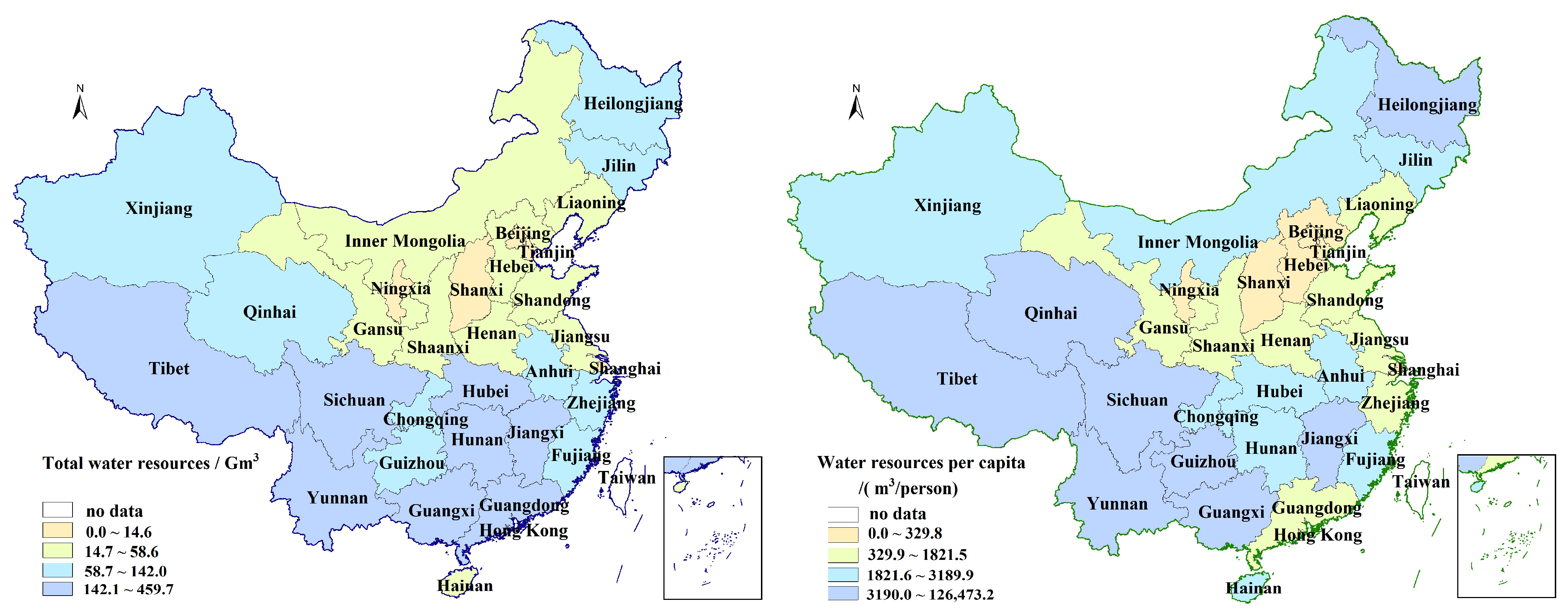
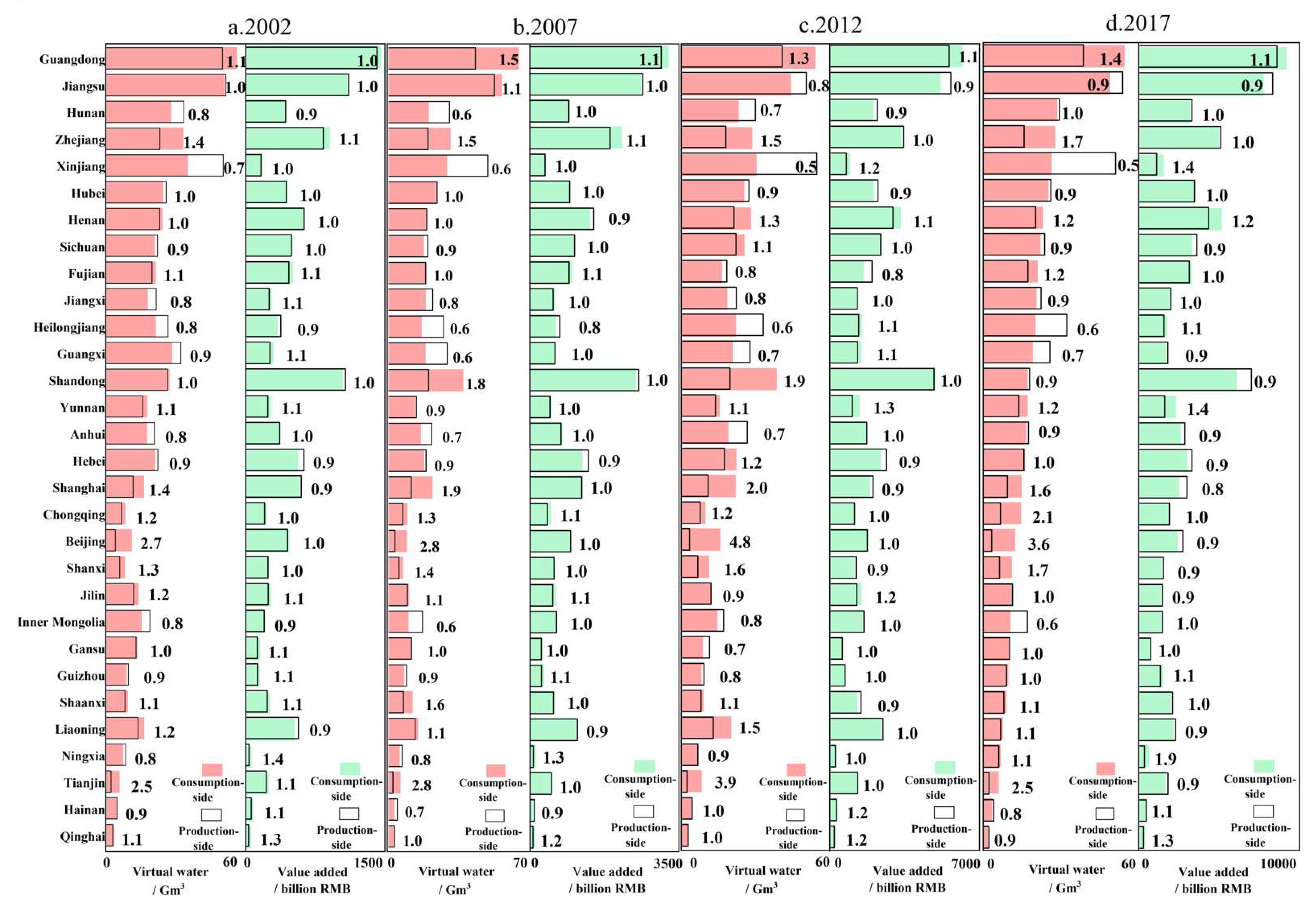

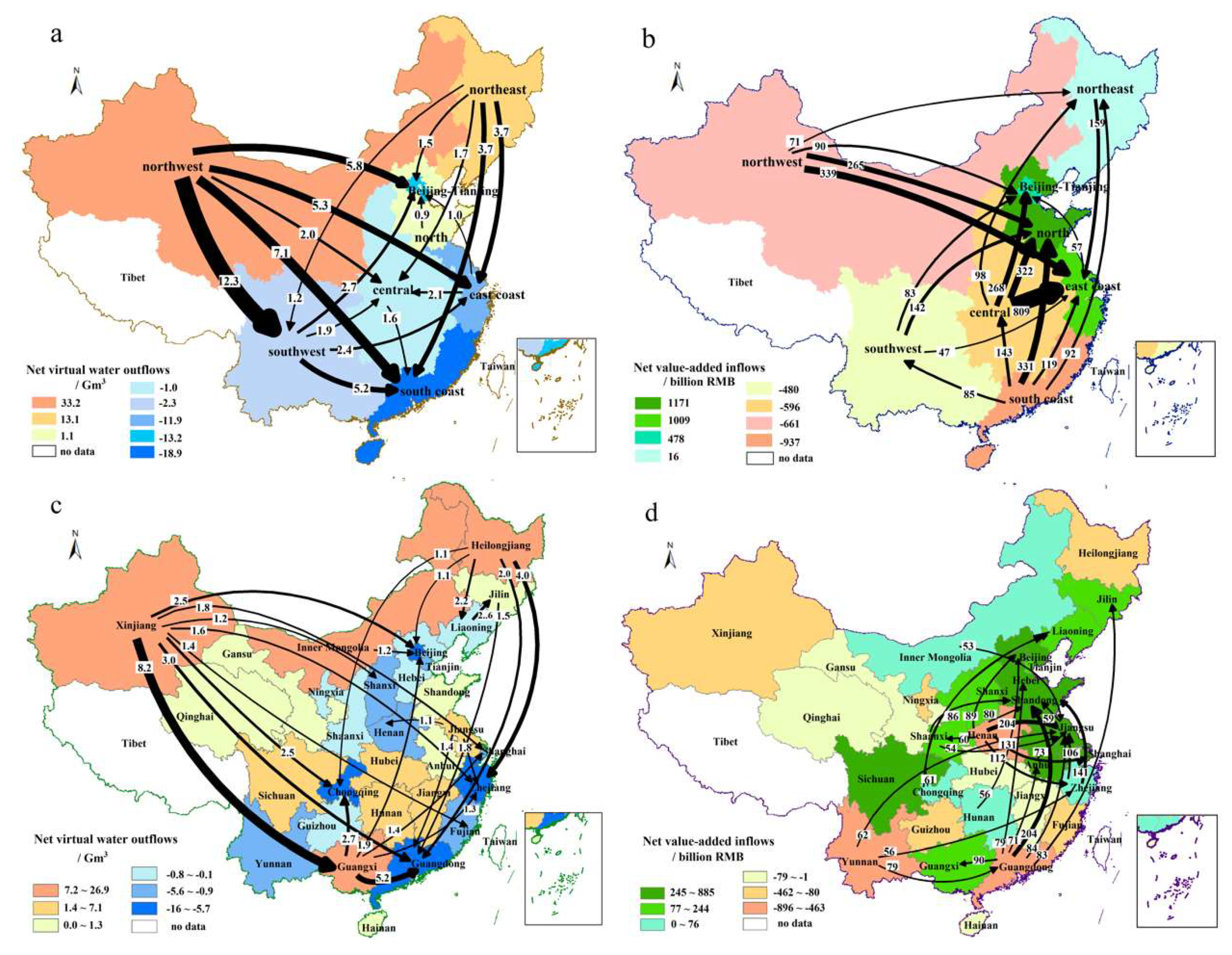
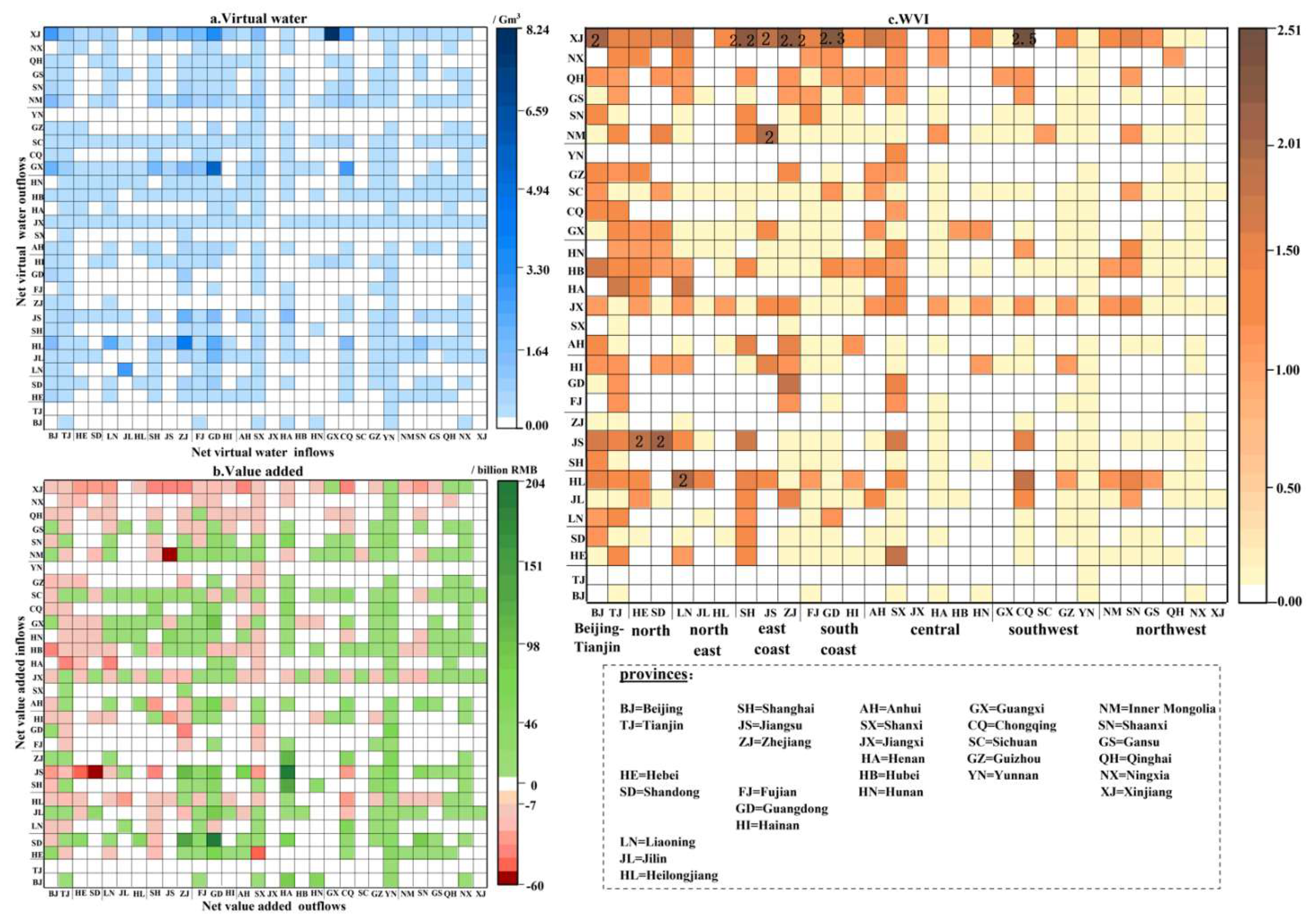
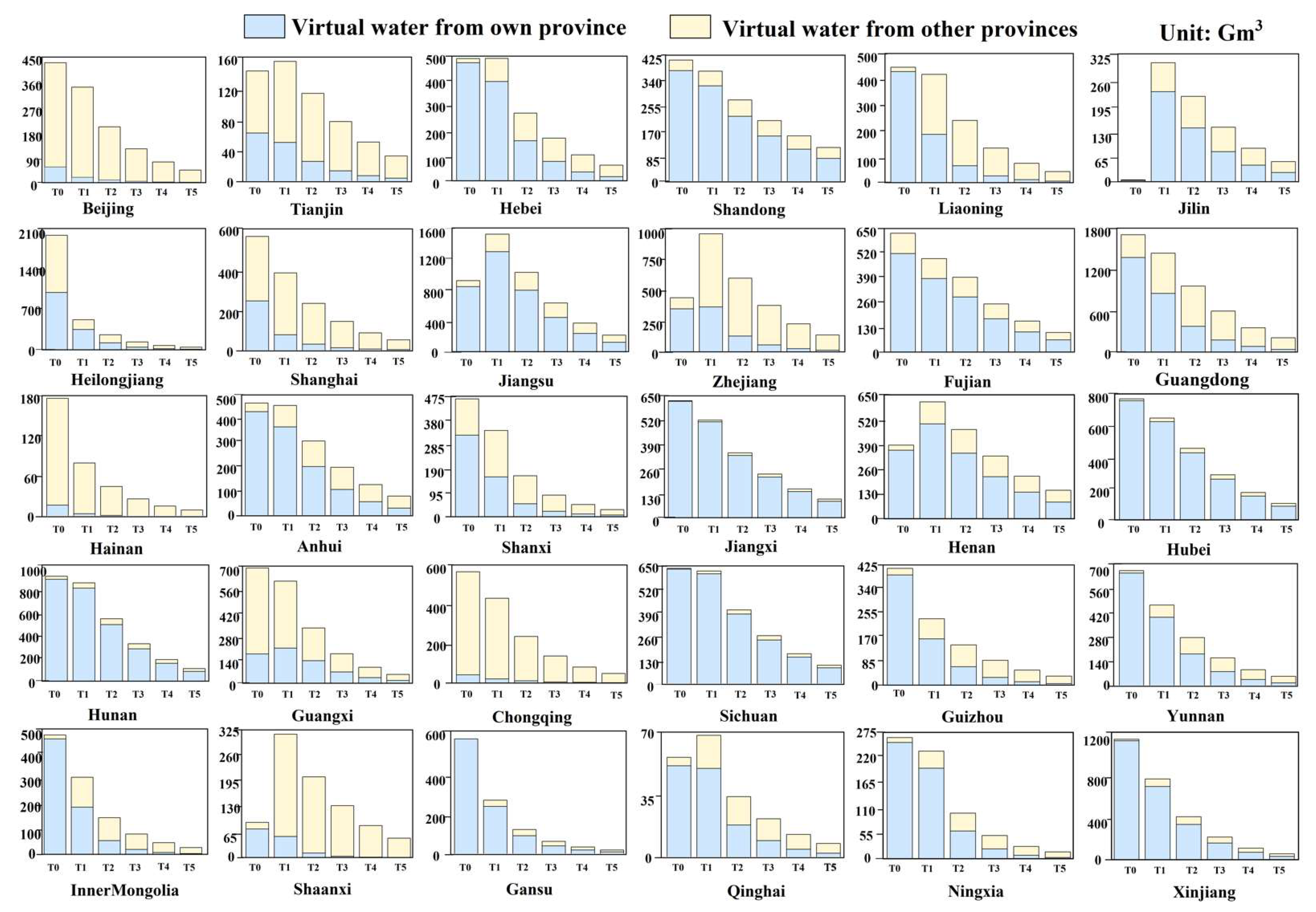
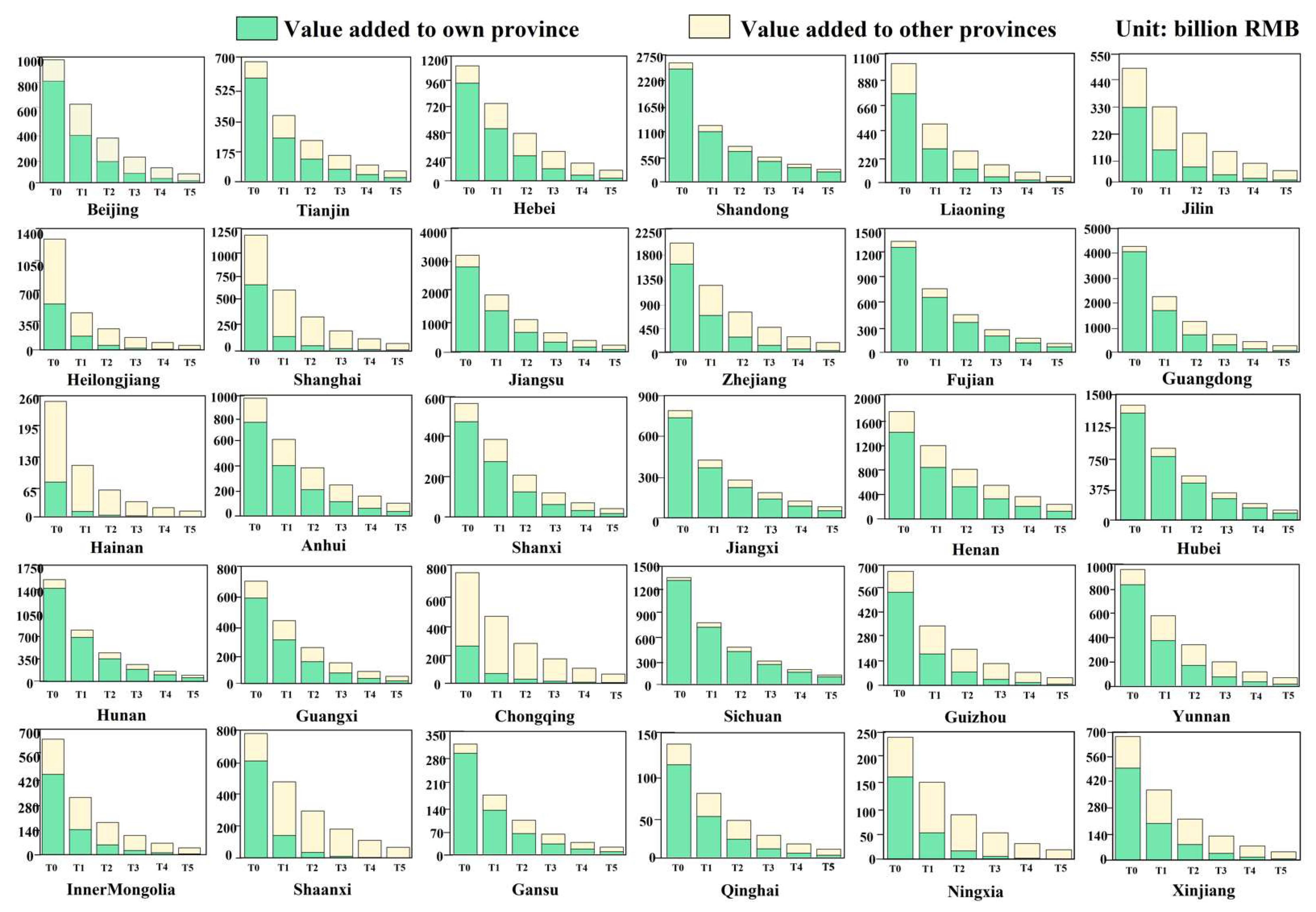
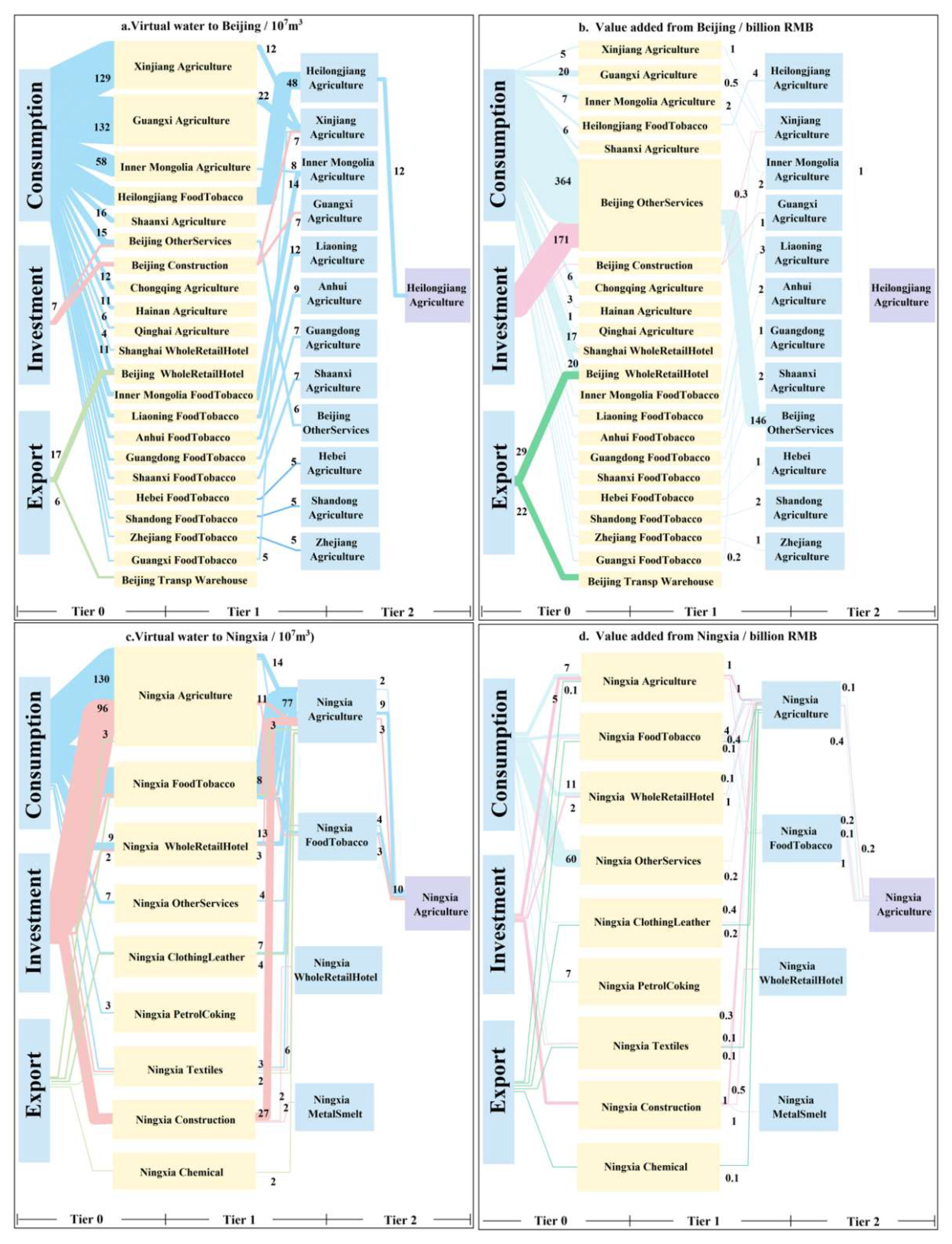
Publisher’s Note: MDPI stays neutral with regard to jurisdictional claims in published maps and institutional affiliations. |
© 2022 by the authors. Licensee MDPI, Basel, Switzerland. This article is an open access article distributed under the terms and conditions of the Creative Commons Attribution (CC BY) license (https://creativecommons.org/licenses/by/4.0/).
Share and Cite
Zheng, J.; Wu, S.; Li, L.; Li, S.; Li, Q.; An, Q. Revealing Virtual Water Transfers and Imbalanced Economic Benefits Hidden in China’s Interprovincial Trade. Water 2022, 14, 1677. https://doi.org/10.3390/w14111677
Zheng J, Wu S, Li L, Li S, Li Q, An Q. Revealing Virtual Water Transfers and Imbalanced Economic Benefits Hidden in China’s Interprovincial Trade. Water. 2022; 14(11):1677. https://doi.org/10.3390/w14111677
Chicago/Turabian StyleZheng, Jie, Sanmang Wu, Li Li, Shantong Li, Qiuping Li, and Qi An. 2022. "Revealing Virtual Water Transfers and Imbalanced Economic Benefits Hidden in China’s Interprovincial Trade" Water 14, no. 11: 1677. https://doi.org/10.3390/w14111677
APA StyleZheng, J., Wu, S., Li, L., Li, S., Li, Q., & An, Q. (2022). Revealing Virtual Water Transfers and Imbalanced Economic Benefits Hidden in China’s Interprovincial Trade. Water, 14(11), 1677. https://doi.org/10.3390/w14111677







